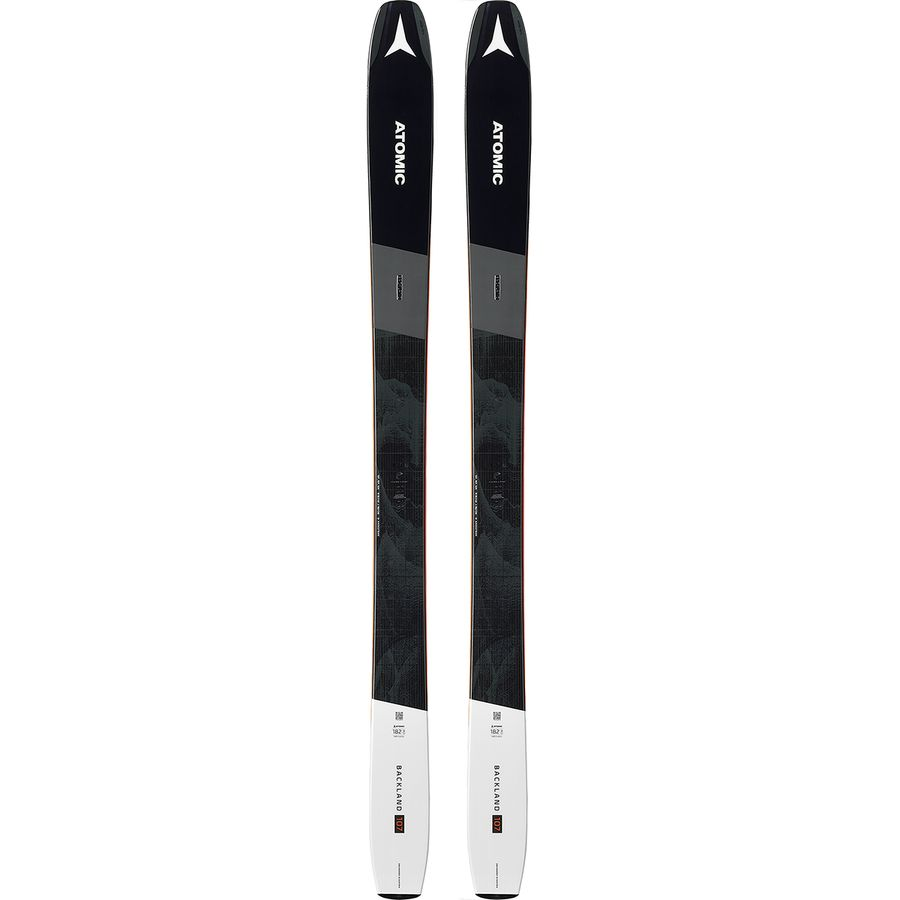



Ah, ski season. If you’re like us and you love hot-lapping the resort and exploring the backcountry, it’s hands down the best time of year. As always, the Active Junky crew has been hard at play this ski season, testing the latest and greatest ski gear to keep you dialed on the mountain.
In this buyer’s guide, you’ll find our favorite resort skis and backcountry skis—not to mention helmets, goggles, apparel, and accessories. Read on and stock up on essential ski gear from top brands like Atomic, Blizzard, Mountain Hardwear, and Glade.
Save money when you shop for ski gear with Active Junky:
No matter if you’re a backcountry purist or an in-bounds ripper, there’s guaranteed to be gear you love in this Buyer’s Guide. And regardless of your skiing experience or style, when you shop for gear with Active Junky, we send you Cash Back for every purchase you make.

It should come as no surprise that Atomic’s award-winning Backland 107 is our top pick for backcountry skiers. If you keep your ear to the ground in the ski world, you’ve undoubtedly heard the stampede of uphill-lovin’ powderhounds clamoring for the Backlands.
After several days spent pushing the Backland 107s high in the Colorado alpine, our backcountry ski tester was head over heels for this lightweight touring ski. Out of the gate, he was blown away by the weight—despite the powder-friendly width, the 107s are light enough to be a dedicated touring ski. And despite the lightweight construction (owed to the featherweight wood core and carbon build), our tester reported that the ski still charges through softer variable conditions.
Given the Backland’s proven versatility, you have two options: pair with a minimalist tech binding for a dedicated pow-slaying backcountry setup, or step up to a Shift binding for a duo that’s ready for everything from lift-accessed laps to human-powered epics.
When our tester analyzed the Backland’s camber profile, he approved of the flat tail with subtle rocker: this ingenious design increases contact with the snow (key for staying glued to steeper skin tracks) but still allows for a quick release out of turns. What’s more, the HRZN Tech Tips aren’t merely a marketing gimmick: these slim tips both improve float in deep snow while maintaining a skinnier profile.
Lastly, given the performance of these skis, we’re stoked on the price. Between the affordable price and the unbelievable performance, expect to see more and more backcountry skiers making their way towards the Backlands over the coming years.
Gripes were few and far between with the Backlands. However, our backcountry ski tester noted that he would love to see a notch in the tails for skin retention. Furthermore, he did note that the Backlands may be overwhelmed in firm chop due to the lightweight build.
Tester Quote: “I paired these with the lightweight G3 Zed bindings resulting in an incredibly lightweight pow-slaying backcountry setup. I found myself with the energy to do one or even two more laps than I would have with a heavier pair of skis.”
Bottom Line: Over the last few years, we’ve watched the Backlands lineup evolve—and we’re now looking at Atomic's best work yet.
It’s no secret that Blizzard’s Rustler 11 has earned top honors from multiple magazines and gear review sites. Our gear reviewers aren’t afraid to go against the status quo, but after our freeride tester pushed this powder ski to its limits, he was quick to agree: the Rustler 11 is deserving of its accolades.
From the first run, our tester was loving the turning chops of these skis. The 180cm Rustler 11 sports a 19m turn radius, and our tester loved arcing medium- and large-radius turns at high velocity on these skis.
A few construction elements help keep the Rustler 11 light, namely the wood Lite Core and Carbon Flipcore D.R.T. Construction. The latter is a construction technique that integrates a stiff section of Titanal underfoot while simultaneously boosting flexibility in the tip and tail. Our tester offered both positive and negative feedback on the subsequent flex pattern. Let’s start with the good stuff: he felt the ski was torsionally stiff enough to hold even the most aggressive of lines. When he mounted them with a pair of Pivot 18s, he commented that he was unsurprised that so many Freeride World Tour athletes throw down on the Rustler 11s in competition.
The construction—combined with a floaty yet versatile rocker-camber-rocker profile and wider waist—creates a ski that can both bounce playfully through chopped up moguls and charge through corridor-tight couloirs.
Our tester’s main concern was in the softness of the tails. He had mixed sentiments on the subject, noting that the softness was ideal for some applications (smooth turns, playful bounce, butters, etc.), but could be a concern in consequential freeride-meets-freestyle applications. To that point, he commented, “Sometimes, the tails would hang the wheelie out a little too long before eventually snapping back under you.” Keep in mind: this tester is a bona fide charger and has no problems keeping up with Freeride World Tour athletes or throwing flips and spins off of 35-foot cliffs.
Speaking of which, after one such cliff-hucking session, he got back on the tram only to discern that he’d bent the nose of one of the Rustler 11s. Now, again, this tester is a wrecking ball—he’s a former U.S. ski team athlete who has built Adirondack chairs out of broken skis (breaking one ski a month is typical for him). He even left a ski sponsor because he was breaking prototypes quicker than they could send ‘em out. For the average joe or even the above-average joe, such an event will likely be a rarity. And for professional athletes or aspiring freeriders on par with our hard-charging ski tester, bending or breaking a ski is simply an “occupational hazard.”
Tester Quote: “Unlike other 'powder' skis, the racing legacy of these Blizzard skis focuses primarily on the turn, and the skis love swoopy medium- through large- radius turns. These skis can handle what you throw at them. If you can think your line, and you can stay on top of these skis, the handling is sublime.”
Bottom Line: For in-bounds skiing, this ski is easy-turning, hard-charging, and a blast and a half in deep snow.

Fact: bibs are superior to ski pants. We predict that sooner rather than later, ski pants will join such 20th-century inventions as the house phone and the VCR in obscurity. In the meantime, we at Active Junky will proceed to ignore ski pants, which we do for two reasons: Firstly, we pledge to equip you, dear reader, with the best gear available (as such, writing about ski pants would be antithetical to our mission). Secondly, the less we write about ski pants, the sooner they become obsolete.
Now that we’ve expressed our allegiance to bibs, allow us to introduce the Mountain Hardwear Boundary Ridge Bibs. These bibs are bombproof and intelligently designed—not to mention crafted with a 3-layer Gore-Tex fabric (Gore-Tex, for those unfamiliar, sets the industry standard in all things “waterproof and breathable”). Furthermore, the suspender configuration is quite comfortable and minimizes the chances of chaffing.
The kangaroo-style pocket in the front of the bibs is perfectly designed. Why, you ask? Well, if you leave pockets with vertical zippers unzipped, phone, wallet, and valuable gummy bears fall into the snow. If you leave pockets with horizontal zippers unzipped, you get back to the car, take off your jacket, see all of your items safe and sound in an open pocket, and think to yourself, “Wow, I’m a dummy. Good thing the designers of these bibs weren’t!”
The rest of the pockets are similarly well designed—there’s ample space in these bibs for all snacks, buffs, chapsticks (why just one?!), and essentials. And if you’re worried about the perils of disrobing in a ski resort bathroom stall to go number two, fear not—zips on the side allow for lightning-fast pit stops.
While the weight is ideal for resort riding (powder days!), the fabric is heavy for hardcore touring (especially on high-output boot packs or warm spring tours. Mountain Hardwear could fix this issue with the addition of a vent on the inner thighs, but alas, their design team did not first consult with our squad on quad overheating.
Tester Quote: “I think I’ll have these bibs for a long, long, long time. They’re on the heavy side, sure, but they’re also really durable and practical in design. For in-bounds use and mid-winter tours, these are my go-to's.”
Bottom Line: Powder skier? Meet your new powder pants.
Active Junky and Glade have much in common: we’re both Colorado-based outdoor companies that want to help you save money on gear. While Active Junky scours the internet for the best deals on outdoor gear, Glade decided to start from the ground up by building high-quality goggles and helmets—and selling them for a reasonable rate.
According to Glade’s website, “Nine of the top ten goggle and helmet brands are now owned by a parent corporation,” and the Breckenridge-based brand is intent on positioning themselves as an independent alternative to those corporate-backed businesses.
We’ve been testing their Tenmile Helmet early this season, and for the most part, we’re big fans. As far as style goes, the Glade Tenmile is on point. Named for Breck’s backyard range, the Tenmile helmet is graced with a geometric depiction of the mountains surrounding Glade’s headquarters. The outline is low-profile, with ten vents and a gentle lip on the brow of the helmet, and the Tenmile is at home from the terrain park to sidecountry terrain. The rotating dial makes it easy to, quite literally, dial in your fit, and the fleecy, soft liner and cushy earpads are as comfortable as helmets that are much more expensive.
Furthermore, the helmet pairs well with the Adapt Photochromic goggles, which we’re stoked on, too. More on that below.
While the price is nice, we generally lean towards helmets equipped with MIPS—this is one of few technologies that’s proven to make a difference with impact-based injuries, and while it’s more expensive, it’s definitely worth the price.
Tester Comment: “I love the style of this helmet, and I’m a strong proponent of buying a helmet and goggles from the same company—so my favorite part of this helmet might just be the fact that it fits the Adapt Goggle!”
Bottom Line: A cheap helmet that doesn’t look cheap, the Tenmile is as pragmatic as it is affordable.

Photochromic lenses are game-changing. Thanks to ocular wizardry beyond our feeble comprehension, photochromic lens tints adapt to varying light conditions. What does this mean? It means that one lens works on both bluebird and overcast days. It means that you can quit worrying about which lens to use or which goggles to rock. And while ditching interchangeable lenses also means less hassle, unfortunately, goggles with photochromic lenses are often just as pricey as premium goggles with interchangeable lens systems. This, dear reader, is where Glade’s Adapt comes in. Priced at a more than reasonable $110 (not including Active Junky Cash Back!), the Adapt offers excellent optical quality, the latest photochromic tech, and a comfortable, flexy, and stylish TPU frame that fits well with most helmets.
When you’re riding in and out of shaded terrain, photochromic lenses aren’t ideal because the tint doesn’t react instantaneously. Note: this is more of a gripe with photochromic lenses in general than with Glade’s Adapt.
Tester Comment: “These goggles are chameleons—they work on low vis days and bright sunny days alike. I’m a big fan of the reflective blue tint when the sun comes out!”
Bottom Line: Affordable and impressive, these photochromic goggles largely eliminate the need for multiple pairs of goggles.